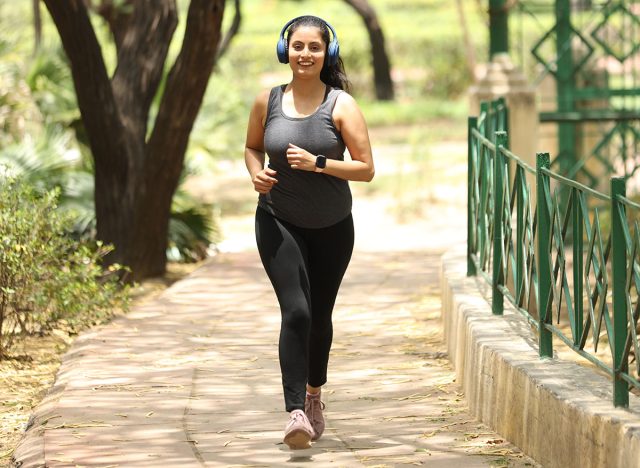If You Can Maintain This Walking Speed, You're Burning Fat Like a Pro

Starting a new fitness journey can feel overwhelming, especially when trying to choose between different cardio exercises. As a health and fitness industry veteran with over 20 years of experience, I've guided countless clients through their fitness journeys. My exercise, nutrition, and personal training expertise with STRIDE Fitness has helped many achieve their transformation goals. Today, I specialize in program design and injury prevention. Read on to discover how to choose the right cardio activity for your fitness level and goals.
How Fast to Walk for Calorie Burn

When choosing between speed walking and jogging for calorie burn, the difference comes down to intensity. Jogging burns more calories than speed walking because it's a more intense cardiovascular activity. Jogging's higher impact nature requires your body to generate more energy to produce the movement, making it naturally more effective for calorie burning.
If you can maintain a walking speed of at least 3.5 to 4.0 mph, you'll be in the optimal zone for fat burning. Walking at this brisk pace keeps your heart rate elevated enough to maximize fat oxidation while still being gentle on your joints. Studies suggest that maintaining this speed for at least 30 to 45 minutes can help you burn more calories efficiently, making it a great alternative to jogging. If you're just starting out, begin at a moderate pace (around 3.0 mph) and gradually work your way up to higher speeds as your endurance improves. For example, if you're walking at 4.0 mph, it should take you about 15 minutes to walk a mile, whereas at 3.5 mph, it would take closer to 17 minutes.
The average walking pace of 3.5 to 4.0 miles per hour can vary depending on factors like an individual's stride length and height. Taller people generally have longer strides, which can result in a faster pace. Additionally, factors such as fitness level, terrain, and walking style also play a role in determining someone's walking speed. It's important to remember that this range is an average, so someone with a shorter stride or different walking mechanics might move at a slower pace, while someone with longer legs or a more brisk walking style might exceed it.
How Your Weight and Fitness Level Impact Calorie Burn

When you are planning your cardio routine, you need to understand your body's unique characteristics. Body weight and fitness level significantly affect how many calories you burn during activities like speed walking or jogging. The more body mass you have—whether from muscle or fat—the harder your body has to work to perform the activity, which leads to a higher calorie burn. Essentially, a person with more weight will burn more calories because their body needs to expend more energy to move.
On the flip side, someone with a higher fitness level might burn slightly fewer calories at the same activity level because their body has adapted to the movement. As you get fitter, your body becomes more efficient, which can lead to burning fewer calories for the same effort.
Why Speed Walking Is Better for Your Joints

While jogging may burn more calories, speed walking offers unique benefits for joint health. Speed walking is less impactful on the ankles, knees, hips, and back, allowing you to get the benefits of cardio and fat burning with less risk of injury or strain on your joints. This makes it an effective option for calorie burning while maintaining joint health.
Why Beginners Should Start With Speed Walking

For those just starting their fitness journey, speed walking is the smarter choice. It's lower impact, meaning there's less stress on your joints, which is key if you're just starting out or dealing with any joint concerns. One of the biggest deterrents to continuing exercise is injury: start small until the body gains strength and endurance.
You'll be able to maintain it longer and build your stamina gradually while still getting solid cardiovascular benefits. It's a great way to ease into fitness without the risk of injury that can come with more intense activities like jogging. And if you enjoyed this article, don't miss How Long Your Walking Workout Should Be To Shrink Belly Fat.









